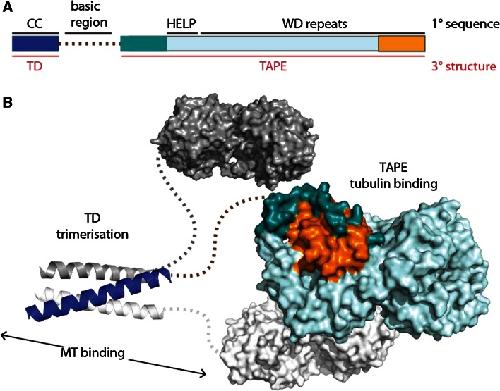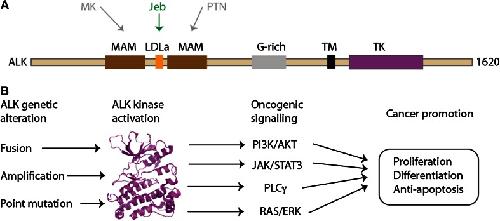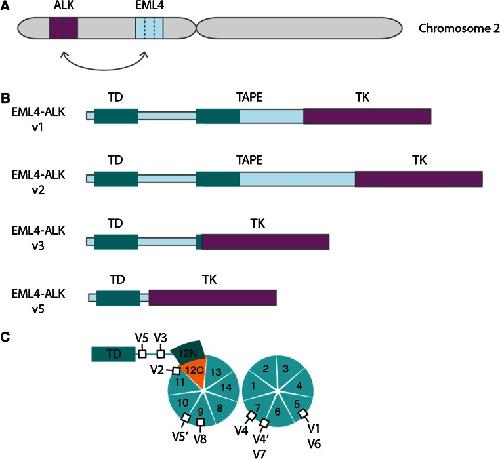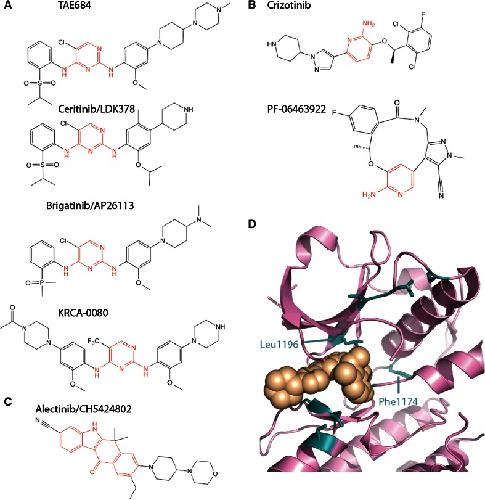ECB-ART-50015
Cell Mol Life Sci
2016 Mar 01;736:1209-24. doi: 10.1007/s00018-015-2117-6.
Show Gene links
Show Anatomy links
Molecular mechanisms that underpin EML4-ALK driven cancers and their response to targeted drugs.
Bayliss R
,
Choi J
,
Fennell DA
,
Fry AM
,
Richards MW
.
???displayArticle.abstract???
A fusion between the EML4 (echinoderm microtubule-associated protein-like) and ALK (anaplastic lymphoma kinase) genes was identified in non-small cell lung cancer (NSCLC) in 2007 and there has been rapid progress in applying this knowledge to the benefit of patients. However, we have a poor understanding of EML4 and ALK biology and there are many challenges to devising the optimal strategy for treating EML4-ALK NSCLC patients. In this review, we describe the biology of EML4 and ALK, explain the main features of EML4-ALK fusion proteins and outline the therapies that target EML4-ALK. In particular, we highlight the recent advances in our understanding of the structures of EML proteins, describe the molecular mechanisms of resistance to ALK inhibitors and assess current thinking about combinations of ALK drugs with inhibitors that target other kinases or Hsp90.
???displayArticle.pubmedLink??? 26755435
???displayArticle.pmcLink??? PMC4761370
???displayArticle.link??? Cell Mol Life Sci
???displayArticle.grants??? [+]
12772 Cancer Research UK, 13-0042 Worldwide Cancer Research, 16-0119 Worldwide Cancer Research, C24461/A12772 Cancer Research UK
???attribute.lit??? ???displayArticles.show???
References [+] :
Azam,
Activation of tyrosine kinases by mutation of the gatekeeper threonine.
2008, Pubmed
Azam, Activation of tyrosine kinases by mutation of the gatekeeper threonine. 2008, Pubmed
Bai, Nucleophosmin-anaplastic lymphoma kinase of large-cell anaplastic lymphoma is a constitutively active tyrosine kinase that utilizes phospholipase C-gamma to mediate its mitogenicity. 1998, Pubmed
Bazigou, Anterograde Jelly belly and Alk receptor tyrosine kinase signaling mediates retinal axon targeting in Drosophila. 2007, Pubmed
Bilsland, Behavioral and neurochemical alterations in mice deficient in anaplastic lymphoma kinase suggest therapeutic potential for psychiatric indications. 2008, Pubmed
Birkbak, Evolutionary Precision Medicine: A Role for Repeat Epidermal Growth Factor Receptor Analysis in ALK-Rearranged Lung Adenocarcinoma? 2015, Pubmed
Bossi, Crystal structures of anaplastic lymphoma kinase in complex with ATP competitive inhibitors. 2010, Pubmed
Busacca, Resistance to HSP90 inhibition involving loss of MCL1 addiction. 2016, Pubmed
Camidge, Taking aim at ALK across the blood-brain barrier. 2013, Pubmed
Cancer Genome Atlas Research Network, Comprehensive molecular profiling of lung adenocarcinoma. 2014, Pubmed
Chen, EML4 promotes the loading of NUDC to the spindle for mitotic progression. 2015, Pubmed , Echinobase
Chiarle, NPM-ALK transgenic mice spontaneously develop T-cell lymphomas and plasma cell tumors. 2003, Pubmed
Chiarle, Stat3 is required for ALK-mediated lymphomagenesis and provides a possible therapeutic target. 2005, Pubmed
Choi, Identification of novel isoforms of the EML4-ALK transforming gene in non-small cell lung cancer. 2008, Pubmed
Choi, EML4-ALK mutations in lung cancer that confer resistance to ALK inhibitors. 2010, Pubmed , Echinobase
Costa, Clinical Experience With Crizotinib in Patients With Advanced ALK-Rearranged Non-Small-Cell Lung Cancer and Brain Metastases. 2015, Pubmed
Crystal, Patient-derived models of acquired resistance can identify effective drug combinations for cancer. 2014, Pubmed
Cui, Structure based drug design of crizotinib (PF-02341066), a potent and selective dual inhibitor of mesenchymal-epithelial transition factor (c-MET) kinase and anaplastic lymphoma kinase (ALK). 2011, Pubmed
Doebele, Mechanisms of resistance to crizotinib in patients with ALK gene rearranged non-small cell lung cancer. 2012, Pubmed
Eccles, NVP-AUY922: a novel heat shock protein 90 inhibitor active against xenograft tumor growth, angiogenesis, and metastasis. 2008, Pubmed
Eichenmuller, The human EMAP-like protein-70 (ELP70) is a microtubule destabilizer that localizes to the mitotic apparatus. 2002, Pubmed , Echinobase
Eichenmüller, Saturable binding of the echinoderm microtubule-associated protein (EMAP) on microtubules, but not filamentous actin or vimentin filaments. 2001, Pubmed , Echinobase
Englund, Jeb signals through the Alk receptor tyrosine kinase to drive visceral muscle fusion. 2003, Pubmed
Fontana, Activity of second-generation ALK inhibitors against crizotinib-resistant mutants in an NPM-ALK model compared to EML4-ALK. 2015, Pubmed
Forbes, COSMIC: exploring the world's knowledge of somatic mutations in human cancer. 2015, Pubmed
Friboulet, The ALK inhibitor ceritinib overcomes crizotinib resistance in non-small cell lung cancer. 2014, Pubmed
Gainor, ALK rearrangements are mutually exclusive with mutations in EGFR or KRAS: an analysis of 1,683 patients with non-small cell lung cancer. 2013, Pubmed
George, Activating mutations in ALK provide a therapeutic target in neuroblastoma. 2008, Pubmed
Hallberg, Mechanistic insight into ALK receptor tyrosine kinase in human cancer biology. 2013, Pubmed
Hartl, Molecular chaperones in protein folding and proteostasis. 2011, Pubmed
Hegyi, Intrinsic structural disorder confers cellular viability on oncogenic fusion proteins. 2009, Pubmed
Heuckmann, Differential protein stability and ALK inhibitor sensitivity of EML4-ALK fusion variants. 2012, Pubmed
Hrustanovic, RAS-MAPK dependence underlies a rational polytherapy strategy in EML4-ALK-positive lung cancer. 2015, Pubmed
Hyman, Vemurafenib in Multiple Nonmelanoma Cancers with BRAF V600 Mutations. 2015, Pubmed
Inamura, EML4-ALK lung cancers are characterized by rare other mutations, a TTF-1 cell lineage, an acinar histology, and young onset. 2009, Pubmed , Echinobase
Iwahara, Molecular characterization of ALK, a receptor tyrosine kinase expressed specifically in the nervous system. 1997, Pubmed
Jänne, AZD9291 in EGFR inhibitor-resistant non-small-cell lung cancer. 2015, Pubmed
Johnson, Discovery of (10R)-7-amino-12-fluoro-2,10,16-trimethyl-15-oxo-10,15,16,17-tetrahydro-2H-8,4-(metheno)pyrazolo[4,3-h][2,5,11]-benzoxadiazacyclotetradecine-3-carbonitrile (PF-06463922), a macrocyclic inhibitor of anaplastic lymphoma kinase (ALK) and c-ros oncogene 1 (ROS1) with preclinical brain exposure and broad-spectrum potency against ALK-resistant mutations. 2014, Pubmed
Kang, Development of potent ALK inhibitor and its molecular inhibitory mechanism against NSCLC harboring EML4-ALK proteins. 2015, Pubmed
Katayama, Mechanisms of acquired crizotinib resistance in ALK-rearranged lung Cancers. 2012, Pubmed
Katayama, Therapeutic strategies to overcome crizotinib resistance in non-small cell lung cancers harboring the fusion oncogene EML4-ALK. 2011, Pubmed , Echinobase
Katayama, Therapeutic targeting of anaplastic lymphoma kinase in lung cancer: a paradigm for precision cancer medicine. 2015, Pubmed
Katayama, Two novel ALK mutations mediate acquired resistance to the next-generation ALK inhibitor alectinib. 2014, Pubmed
Kinoshita, Design and synthesis of a highly selective, orally active and potent anaplastic lymphoma kinase inhibitor (CH5424802). 2012, Pubmed
Koivunen, EML4-ALK fusion gene and efficacy of an ALK kinase inhibitor in lung cancer. 2008, Pubmed
Kuefer, Retrovirus-mediated gene transfer of NPM-ALK causes lymphoid malignancy in mice. 1997, Pubmed
Kwak, Anaplastic lymphoma kinase inhibition in non-small-cell lung cancer. 2010, Pubmed
Lasek, An evolutionary conserved role for anaplastic lymphoma kinase in behavioral responses to ethanol. 2011, Pubmed
Lee, Crystal structure of the ALK (anaplastic lymphoma kinase) catalytic domain. 2010, Pubmed
Li, Evaluation of EML4-ALK fusion proteins in non-small cell lung cancer using small molecule inhibitors. 2011, Pubmed , Echinobase
Li, Clinical significance of EML4-ALK fusion gene and association with EGFR and KRAS gene mutations in 208 Chinese patients with non-small cell lung cancer. 2013, Pubmed
Li, Molecular characterization of the 77-kDa echinoderm microtubule-associated protein. Homology to the beta-transducin family. 1994, Pubmed , Echinobase
Lovly, Rationale for co-targeting IGF-1R and ALK in ALK fusion-positive lung cancer. 2014, Pubmed
Lynch, Activating mutations in the epidermal growth factor receptor underlying responsiveness of non-small-cell lung cancer to gefitinib. 2004, Pubmed
Maggiora, Overexpression of the RON gene in human breast carcinoma. 1998, Pubmed
Manning, The protein kinase complement of the human genome. 2002, Pubmed
Marsilje, Synthesis, structure-activity relationships, and in vivo efficacy of the novel potent and selective anaplastic lymphoma kinase (ALK) inhibitor 5-chloro-N2-(2-isopropoxy-5-methyl-4-(piperidin-4-yl)phenyl)-N4-(2-(isopropylsulfonyl)phenyl)pyrimidine-2,4-diamine (LDK378) currently in phase 1 and phase 2 clinical trials. 2013, Pubmed
Mathivet, In contrast to agonist monoclonal antibodies, both C-terminal truncated form and full length form of Pleiotrophin failed to activate vertebrate ALK (anaplastic lymphoma kinase)? 2007, Pubmed
McCollum, Up-regulation of heat shock protein 27 induces resistance to 17-allylamino-demethoxygeldanamycin through a glutathione-mediated mechanism. 2006, Pubmed
McDermott, Genomic alterations of anaplastic lymphoma kinase may sensitize tumors to anaplastic lymphoma kinase inhibitors. 2008, Pubmed
Mok, Gefitinib or carboplatin-paclitaxel in pulmonary adenocarcinoma. 2009, Pubmed
Morris, Fusion of a kinase gene, ALK, to a nucleolar protein gene, NPM, in non-Hodgkin's lymphoma. 1994, Pubmed
Neckers, Hsp90 molecular chaperone inhibitors: are we there yet? 2012, Pubmed
Normant, The Hsp90 inhibitor IPI-504 rapidly lowers EML4-ALK levels and induces tumor regression in ALK-driven NSCLC models. 2011, Pubmed , Echinobase
Ota, Induction of PD-L1 Expression by the EML4-ALK Oncoprotein and Downstream Signaling Pathways in Non-Small Cell Lung Cancer. 2015, Pubmed
Ou, I1171 missense mutation (particularly I1171N) is a common resistance mutation in ALK-positive NSCLC patients who have progressive disease while on alectinib and is sensitive to ceritinib. 2015, Pubmed
Paez, EGFR mutations in lung cancer: correlation with clinical response to gefitinib therapy. 2004, Pubmed
Palacios, Il-3-dependent mouse clones that express B-220 surface antigen, contain Ig genes in germ-line configuration, and generate B lymphocytes in vivo. 1985, Pubmed
Park, Mechanism of met oncogene activation. 1986, Pubmed
Pollmann, Human EML4, a novel member of the EMAP family, is essential for microtubule formation. 2006, Pubmed
Richards, Microtubule association of EML proteins and the EML4-ALK variant 3 oncoprotein require an N-terminal trimerization domain. 2015, Pubmed , Echinobase
Richards, Crystal structure of EML1 reveals the basis for Hsp90 dependence of oncogenic EML4-ALK by disruption of an atypical β-propeller domain. 2014, Pubmed , Echinobase
Rikova, Global survey of phosphotyrosine signaling identifies oncogenic kinases in lung cancer. 2007, Pubmed
Roe, Structural basis for inhibition of the Hsp90 molecular chaperone by the antitumor antibiotics radicicol and geldanamycin. 1999, Pubmed
Rohrbough, Anterograde Jelly belly ligand to Alk receptor signaling at developing synapses is regulated by Mind the gap. 2010, Pubmed
Rolfo, ALK and crizotinib: after the honeymoon…what else? Resistance mechanisms and new therapies to overcome it. 2014, Pubmed
Saibil, Chaperone machines for protein folding, unfolding and disaggregation. 2013, Pubmed
Sanders, Exon scanning by reverse transcriptase-polymerase chain reaction for detection of known and novel EML4-ALK fusion variants in non-small cell lung cancer. 2011, Pubmed
Sang, Targeted inhibition of the molecular chaperone Hsp90 overcomes ALK inhibitor resistance in non-small cell lung cancer. 2013, Pubmed
Santoro, Point mutations in the tyrosine kinase domain release the oncogenic and metastatic potential of the Ron receptor. 1998, Pubmed
Sasaki, The biology and treatment of EML4-ALK non-small cell lung cancer. 2010, Pubmed , Echinobase
Sasaki, A novel ALK secondary mutation and EGFR signaling cause resistance to ALK kinase inhibitors. 2011, Pubmed
Sequist, Activity of IPI-504, a novel heat-shock protein 90 inhibitor, in patients with molecularly defined non-small-cell lung cancer. 2010, Pubmed
Sharma, Targeting of the protein chaperone, HSP90, by the transformation suppressing agent, radicicol. 1998, Pubmed
Shaw, Clinical features and outcome of patients with non-small-cell lung cancer who harbor EML4-ALK. 2009, Pubmed
Shaw, Ceritinib in ALK-rearranged non-small-cell lung cancer. 2014, Pubmed
Shaw, Crizotinib in ROS1-rearranged non-small-cell lung cancer. 2014, Pubmed
Shaw, Crizotinib versus chemotherapy in advanced ALK-positive lung cancer. 2013, Pubmed
Shiota, Hyperphosphorylation of a novel 80 kDa protein-tyrosine kinase similar to Ltk in a human Ki-1 lymphoma cell line, AMS3. 1994, Pubmed
Singh, Transforming fusions of FGFR and TACC genes in human glioblastoma. 2012, Pubmed
Soda, Identification of the transforming EML4-ALK fusion gene in non-small-cell lung cancer. 2007, Pubmed , Echinobase
Solomon, First-line crizotinib versus chemotherapy in ALK-positive lung cancer. 2014, Pubmed
Stebbins, Crystal structure of an Hsp90-geldanamycin complex: targeting of a protein chaperone by an antitumor agent. 1997, Pubmed
Stirnimann, WD40 proteins propel cellular networks. 2010, Pubmed
Stoica, Midkine binds to anaplastic lymphoma kinase (ALK) and acts as a growth factor for different cell types. 2002, Pubmed
Stoica, Identification of anaplastic lymphoma kinase as a receptor for the growth factor pleiotrophin. 2001, Pubmed
Suprenant, Conservation of the WD-repeat, microtubule-binding protein, EMAP, in sea urchins, humans, and the nematode C. elegans. 2000, Pubmed , Echinobase
Suprenant, EMAP, an echinoderm microtubule-associated protein found in microtubule-ribosome complexes. 1993, Pubmed , Echinobase
Tabbó, ALK Signaling and Target Therapy in Anaplastic Large Cell Lymphoma. 2012, Pubmed
Takahashi, Clinicopathologic features of non-small-cell lung cancer with EML4-ALK fusion gene. 2010, Pubmed , Echinobase
Takeuchi, Multiplex reverse transcription-PCR screening for EML4-ALK fusion transcripts. 2008, Pubmed
Takeuchi, KIF5B-ALK, a novel fusion oncokinase identified by an immunohistochemistry-based diagnostic system for ALK-positive lung cancer. 2009, Pubmed
Tanimoto, Receptor ligand-triggered resistance to alectinib and its circumvention by Hsp90 inhibition in EML4-ALK lung cancer cells. 2014, Pubmed , Echinobase
Tanizaki, Combined effect of ALK and MEK inhibitors in EML4-ALK-positive non-small-cell lung cancer cells. 2012, Pubmed , Echinobase
Tegha-Dunghu, EML3 is a nuclear microtubule-binding protein required for the correct alignment of chromosomes in metaphase. 2008, Pubmed
Toyokawa, Identification of a Novel ALK G1123S Mutation in a Patient with ALK-rearranged Non-small-cell Lung Cancer Exhibiting Resistance to Ceritinib. 2015, Pubmed
Vernersson, Characterization of the expression of the ALK receptor tyrosine kinase in mice. 2006, Pubmed
Wellstein, ALK receptor activation, ligands and therapeutic targeting in glioblastoma and in other cancers. 2012, Pubmed
Whitesell, Inhibition of heat shock protein HSP90-pp60v-src heteroprotein complex formation by benzoquinone ansamycins: essential role for stress proteins in oncogenic transformation. 1994, Pubmed
Wilson, A functional landscape of resistance to ALK inhibition in lung cancer. 2015, Pubmed
Wong, The EML4-ALK fusion gene is involved in various histologic types of lung cancers from nonsmokers with wild-type EGFR and KRAS. 2009, Pubmed , Echinobase
Ying, Ganetespib, a unique triazolone-containing Hsp90 inhibitor, exhibits potent antitumor activity and a superior safety profile for cancer therapy. 2012, Pubmed
Yuza, Allele-dependent variation in the relative cellular potency of distinct EGFR inhibitors. 2007, Pubmed
Zhao, Lung adenocarcinoma harboring concomitant EGFR mutation and EML4-ALK fusion that benefits from three kinds of tyrosine kinase inhibitors: a case report and literature review. 2015, Pubmed
Zou, PF-06463922, an ALK/ROS1 Inhibitor, Overcomes Resistance to First and Second Generation ALK Inhibitors in Preclinical Models. 2015, Pubmed




